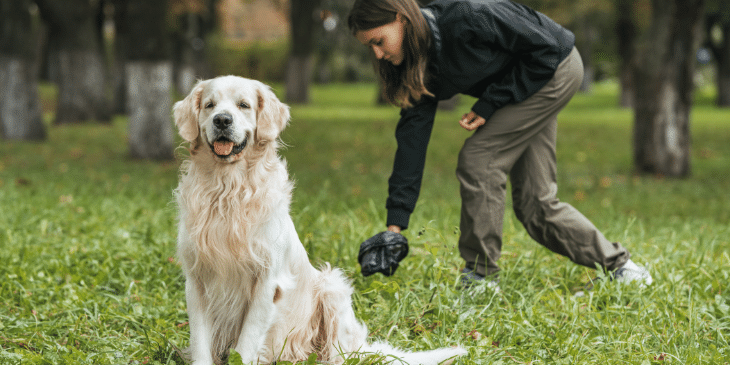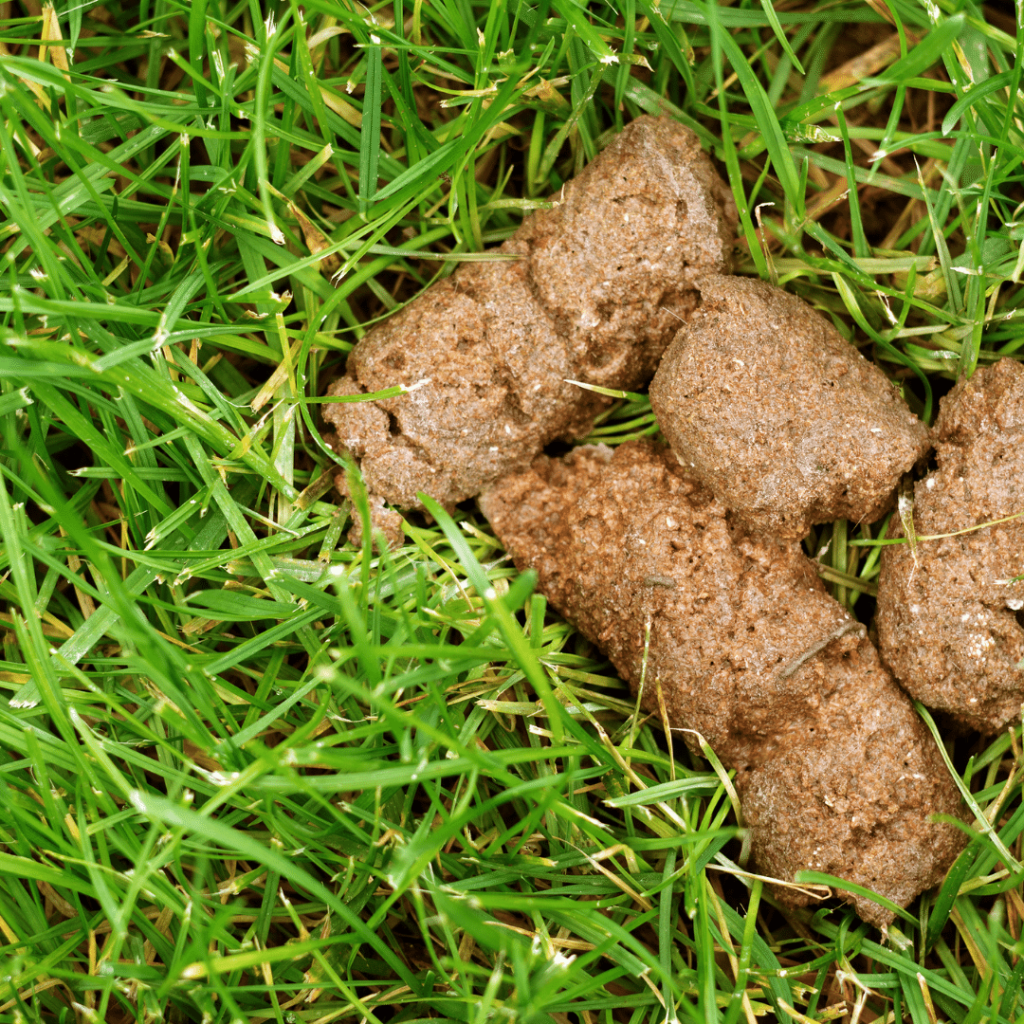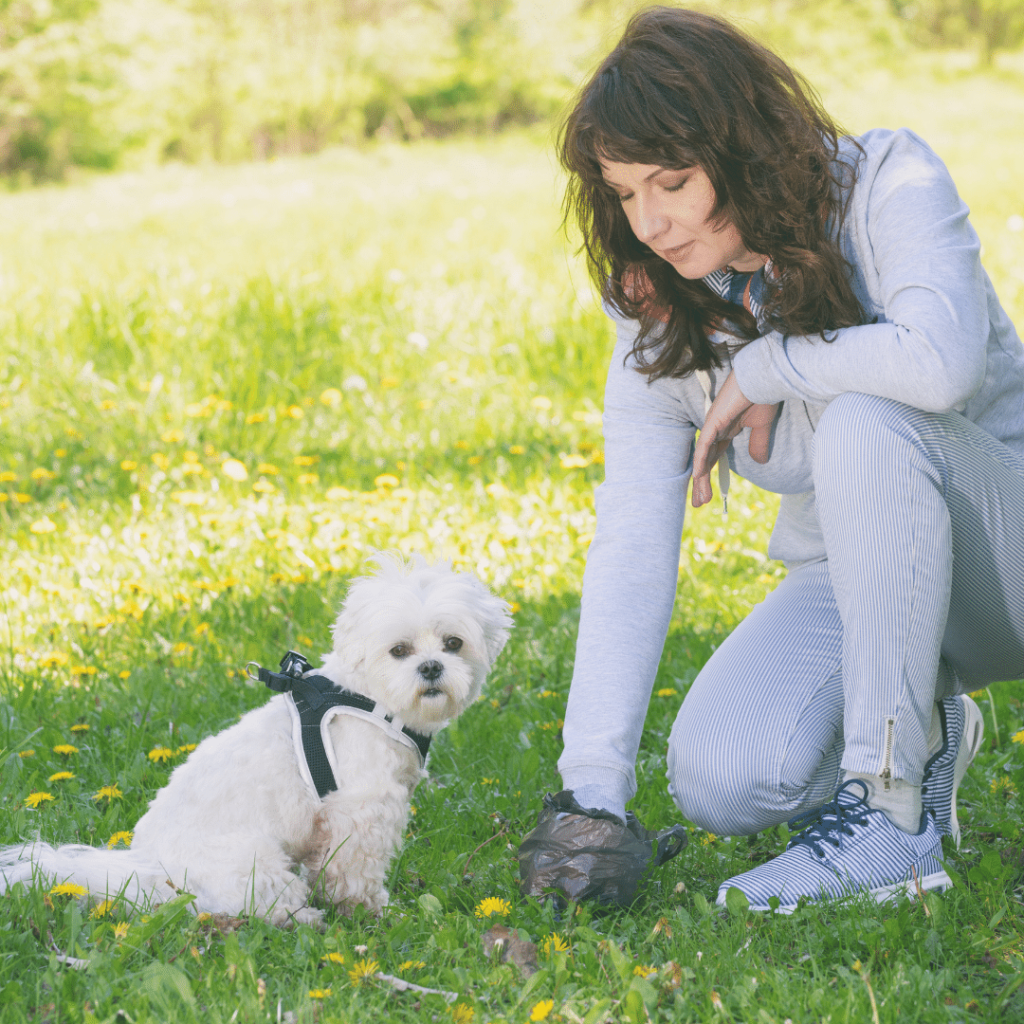Dog Poop Color Meaning: What’s Normal and What Isn’t?

Contents
Did you know that the color of your dog’s poop can tell you a lot about his overall health? No dog owner enjoys cleaning up their dog’s poop! But being observant of any irregularities in your dog’s stool could help you catch health problems early before they become serious.
Understanding dog poop color meaning and other poop-related issues to look for can help you determine what’s normal and what isn’t. That way, if you notice something out of the ordinary you can make an educated decision about what to do next and when to call the vet.
Dog Poop Color Meaning – Here’s What Each Color Means
If your dog’s poop is looking a little funky, this dog poop color meaning chart can help you figure out what it might mean and what to do next.

Normal dog poop is medium brown in color and firm in consistency.
· Brown Dog Poop
Normal dog poop is medium brown in color and firm in consistency. Normal stools are easy to pick up and not too hard or too soft. Firm brown dog poop indicates good digestive health and it’s exactly what you want to see.
· Maroon or Black Dog Poop with a Tarry Consistency
Dog poop that’s very dark black or maroon with a tarry consistency probably contains blood that has been digested. It could mean that there’s bleeding somewhere in the dog’s upper GI tract or large intestine and the blood has passed through the digestive system. It could indicate an ulcer, parasites, or something more serious, so contact the vet right away.
· Red Streaks or Red Specks in Dog Poop
Red specks or red streaks in your dog’s poop may also indicate that he is bleeding internally, probably somewhere in his small intestine. Small amounts of undigested blood in the stool don’t usually indicate an emergency.
However, you should watch your pet closely and call the vet at the first sign of pain or illness. If the condition persists for more than one stool call the vet to rule out an anal gland infection, inflamed colon, rectal injury, or a tumor.
On the other hand, if your pooch has bloody diarrhea, it should be treated as an emergency. Diarrhea with blood can lead to rapid dehydration and warrants immediate action.
It’s also important to note that bright red kibbles in your dog’s food could also give your dog’s stool a reddish appearance. But this won’t be something that comes on suddenly and the stool will look normal otherwise. It will be a regular occurrence for as long as he’s on the food with red kibble.
· Purple or Pink Dog Poop
Purple or pink dog poop may indicate that your dog has eaten something he shouldn’t. But it could also indicate blood in the stool. In fact, bloody diarrhea can sometimes take on the appearance of purple jam. If you believe your dog is passing blood in his stool, it’s time to call the vet.
It’s also important to note that stools that look like raspberry jam may indicate the onset of hemorrhagic gastroenteritis (HGE). This disease can be fatal because it leads to sudden and severe diarrhea and vomiting. If you suspect HGE, seek immediate emergency care.
· Gray Dog Poop
Gray dog poop could indicate a few different things. If the poop has been sitting out in the yard for a day or two, it likely turned gray as it aged and it’s nothing to worry about.
However, if you notice gray stool as your dog is passing it, he could have a digestive issue or a problem with his pancreas. In this case, give the vet a call right away.
· Green Dog Poop
Green poop is fairly common in dogs, and while it’s not entirely normal, it’s not always cause for concern either. It could simply mean that your pet has been eating too much grass or some other plant matter. He may have an upset stomach, so it’s definitely something to keep an eye on.
However, it could also be a sign that your dog has eaten something poisonous, has intestinal parasites, or a bacterial infection. If the condition persists for more than one bowel movement or your dog is displaying any other signs of illness, contact the vet right away.
· Orange or Yellow Dog Poop
Yellow dog poop could indicate a number of things when it comes to your dog’s health. The most common is a food intolerance, often related to a recent change in diet. However, it could also be indicative of biliary or liver disease, especially if the stools are pasty in texture. If you haven’t changed your dog’s food recently or the condition persists for more than 24 hours, call the vet for advice.
· White Specks in Dog Poop
If your dog poop is a normal brown color with white specks in it, the white specks may be cause for concern. They could be the remnants of something your dog has eaten, so keep an eye out for any other signs of tummy troubles.
If the white specks are moving, you are most likely dealing with intestinal parasites- otherwise known as worms. Some worms come out in a dog’s poop when they reach adulthood and may look like white specks or white noodles in the stool. If you suspect worms, schedule an appointment with your vet for treatment and be prepared to provide a stool sample.
· White/Chalky Dog Poop
White or chalky dog poop definitely isn’t normal. However, it is common for dogs who are fed a raw food diet to have chalky white poop. It usually indicates that the dog is consuming too many bones, or his diet is too high in calcium. If the condition persists for more than two or three bowel movements, check with your vet for advice, especially if he’s also showing signs of constipation.
· Dog Poop with Mucus
A small amount of mucus on your dog’s poop is normal. The intestine is covered with mucus to help the stool pass, and you may see small amounts of it from time to time.
However, large amounts of mucus on your dog’s stool could indicate a digestive issue. The intestine produces excess mucus when it is inflamed from things like intestinal parasites, illness, infections, and other intestinal issues. If you’re suddenly noticing large amounts of mucus in your dog’s poop, call the vet for advice.
· Greasy Looking Dog Poop
If your dog’s poop has a greasy appearance, it could indicate an issue with his pancreas, called pancreatitis. Pancreatitis can range from mild to life-threatening, so it’s best not to take any chances.
Greasy dog poop may also indicate a condition called Exocrine Pancreatic Insufficiency (EPI). EPI is sometimes called maldigestion. It occurs when the pancreas isn’t producing the enzymes required for digesting fat. This condition should be treated by your vet.
Why You Should Pay Attention to the Color of Your Dog’s Poop

Always pay attention to the color, consistency, coating, and contents of your dog’s poop.
Your first instinct is probably to avoid looking at your dog’s poop, and we don’t blame you. But you really should pay attention to the color, consistency, coating, and contents of your dog’s poop. That’s because the appearance of your dog’s stool can tell you a lot about his overall health and may clue you into issues you may not have noticed otherwise.
How to Assess Your Dog’s Poop: The Four Cs of Dog Poop
Dog owners can use the “four Cs of dog poop” to assess their dog’s poop on a daily basis:
Consistency: Firm stools are normal for dogs. If the stool comes out hard or in small pellets, your dog may be constipated. On the other hand, the stools shouldn’t be so soft that you can’t scoop them up easily, and they should never be runny or watery.
Coating: Normal dog poop shouldn’t have a coating of any kind. A coating of mucus or blood is not normal and is cause for concern.
Contents: Be on the lookout for anything unusual in your dog’s poop that may indicate he’s eaten something he shouldn’t. It’s not uncommon to find hair in dog poop, food wrappers, or even sticks… or maybe a chicken bone scrounged out of the trash. Be on the lookout for intestinal parasites, too.
Color: Healthy poop color is brown, but dog poop can change colors for a number of reasons. If your dog’s poop is any color other than brown, read the chart above for the most common dog poop color meanings and what to do next.
How Diet Can Affect the Color of Your Dog’s Poop
Your dog’s diet can affect the color of his poop in a number of ways, from changes in consistency to color. Follow these tips to keep your dog’s poop healthy and avoid unnecessary veterinary expenses.
- Feed the highest quality diet you can afford and stay consistent with the type of food you feed.
- If you must change your dog’s food, do it gradually over time by mixing small amounts of the new food in with the old. Increasing the new food a little bit at a time until he’s completely switched over.
- Some human foods are safe for dogs in small amounts, but moderation is key. And be aware that even safe human foods can trigger allergy symptoms or digestive upset, so introduce new foods with caution.
- Keep your pet away from trash and compost piles.
- Be aware of any toxic plants that may be growing in your yard or houseplants inside your home that could make your dog sick.
- Never give your dog human medications without specific instructions from your vet.
- Keep all lawn, garden, household, car care, and personal care chemicals out of reach.
Dog Poop Color Meaning: When to Call the Vet
So, when should you call your vet about changes in your dog’s poop? It’s probably best to call the vet for advice any time you notice sudden changes in his stool. As long as your dog hasn’t had a diet change, his poop should stay about the same from day to day.
Blood in the stool, excessive diarrhea, or abnormal stools with other signs of pain or illness should be treated as an emergency. Vomiting, diarrhea, lethargy, breathing issues, and behavior changes with abnormal stools could indicate a medical emergency. Take your dog to the closest veterinarian or after-hours emergency animal hospital immediately.
Keep in mind that yellow, purple, black, or red stool could indicate a serious medical issue as well. It’s best to contact your vet immediately in these situations as well. If you’re on a budget, check out these tips for saving money on vet bills. Money should never get in the way when it comes to your dog’s health!
How to Collect a Poop Sample for Your Vet
Your vet may request a sample of your dog’s poop to help him diagnose any issues, especially parasites. Ensure that the sample is freshly collected within the last six hours.
To collect the sample, simply turn a plastic baggie inside out over your hand and collect a sample that’s about ½ teaspoon in size. Turn the baggie right side out around the sample and seal it tightly.
Store the sample in your fridge until you’re ready to go in for your appointment.
Frequently Asked Questions About Dog Poop Color Meaning
· What does it mean when there’s blood in my dog’s poop?
Blood in your dog’s poo could indicate a number of things. If there’s just a tiny trace of blood, it may be something as simple as a tear or a small cut around the anus. Check the area carefully for any sign of injury and call the vet if you find anything concerning.
If you notice a large amount of bright red fresh blood or black digested blood, or if there’s diarrhea, call the vet immediately to rule out any serious health issues.
· Why does my dog’s poop color change?
The color of your dog’s poop can change due to something he’s eaten or a health condition. See the chart above for common dog poop color meanings and what to do next.
· What should I do if I see worms in my dog’s poop?
If you see worms in your dog’s poop, make an appointment with your vet. Proper diagnosis is required to determine the right course of treatment, depending on the type of worms your dog has.
· What is normal poop color for a dog?
Normal poop color for a dog is medium brown, but slight variations usually aren’t anything to be concerned about. Sudden changes in the color of your dog’s poop could indicate an issue and should be addressed immediately as advised in the chart above.
Wrapping Things Up
Overall, normal, healthy dog poop is medium brown in color and firm in consistency. The dog poop color meaning chart above will help you determine what an abnormal poop color might mean and what to do next. Remember, if you have any doubts, calling the vet is always a good idea, even if it’s just for your own peace of mind.
